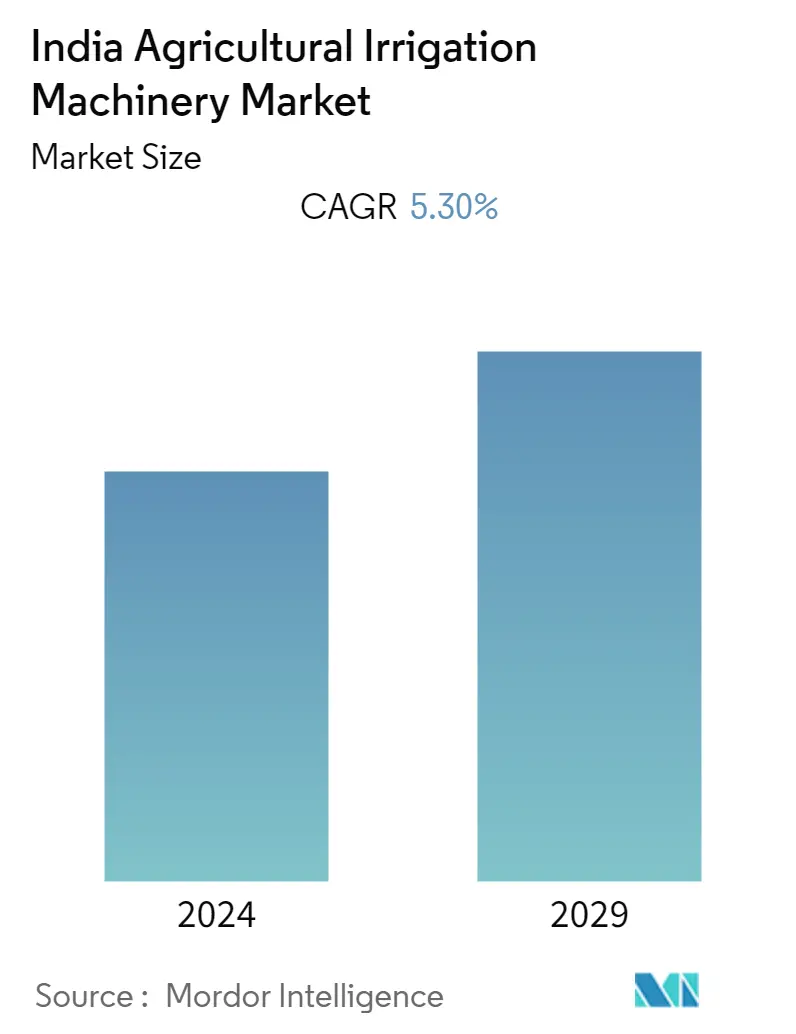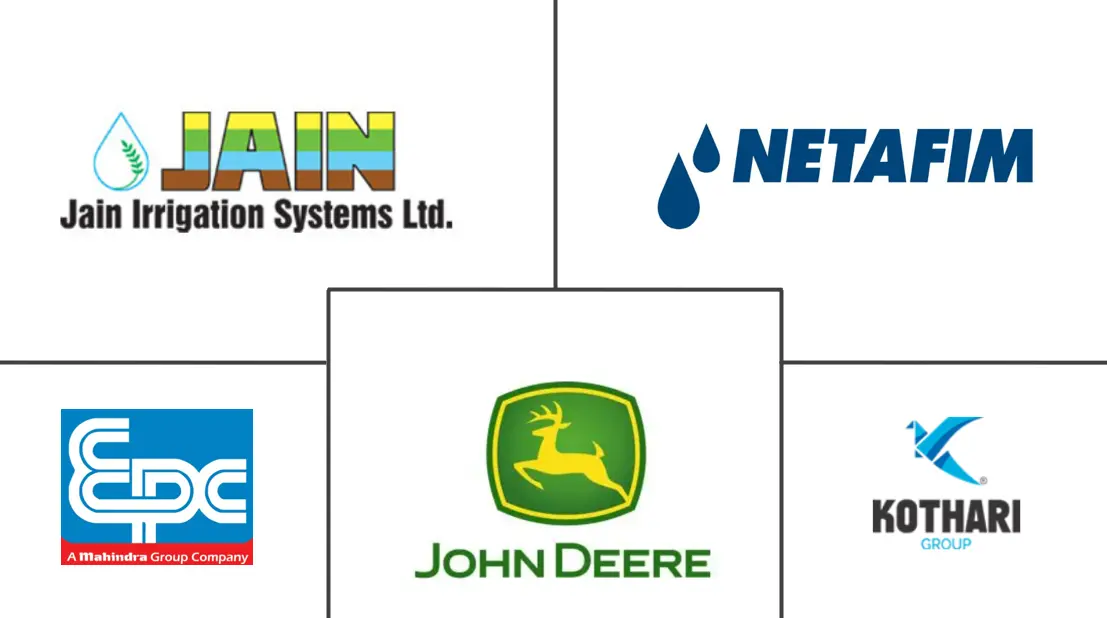Market Size of India Agricultural Irrigation Machinery Industry

| Study Period | 2019 - 2029 |
| Base Year For Estimation | 2023 |
| Forecast Data Period | 2024 - 2029 |
| Historical Data Period | 2019 - 2022 |
| CAGR | 5.30 % |
| Market Concentration | High |
Major Players
*Disclaimer: Major Players sorted in no particular order |
India Agricultural Irrigation Machinery Market Analysis
The Indian Agricultural Irrigation Machinery market is projected to register a CAGR of 5.3% during the forecast period.
- Water scarcity being the major concern in the current agricultural scenario is the foremost driving factor for the growth of this sector followed by the awareness about the micro-irrigation system, and the need for high productivity to meet the food demand due to the increased population. According to the press released by the Ministry of Agriculture and Farmer's Welfare, 2021, the net irrigated area in the country is 68,649 thousand hectares. The agricultural land covered under micro-irrigation is 12,908.44 thousand hectares.
- Microirrigation system contributes around 18-20% of the total irrigation, consisting of both drip irrigation and sprinkler irrigation systems. States like Karnataka, Gujrat, Andhra Pradesh, Rajasthan, Maharashtra, and Haryana are some major states utilizing micro-irrigation systems attributed to the large cultivable area and area under irrigation. The Indian micro-irrigation market is highly competitive, with large and small-scale drip and sprinkler irrigation equipment producers and marketers across numerous states in India. Current agricultural scenario water scarcity has been a major challenge in India and is, thereby, a critical driver for the use of micro-irrigation machinery systems.
- India faces typical water issues, primarily due to population growth and lack of availability of quality water, the demand for agricultural irrigation machinery is rapidly increasing in India. The irrigation machinery market in India is a high-volume and highly competitive space. The growth of the market has been consistent and is particularly high in the regions of Maharashtra, Andhra Pradesh, Gujarat, Karnataka, and Tamil Nadu. The impact of using drip irrigation is well perceived in the country due to the various political and social awareness campaigns that have promoted the technology in the country.
India Agricultural Irrigation Machinery Industry Segmentation
Agricultural Irrigation Machineries are a system that distributes water under low pressure through a piped network and applies it as a small discharge to each plant. Micro-irrigation uses less pressure and water flow than sprinkler irrigation. The report presents a deeper analysis of Industry, Growth, and trend of Agricultural irrigation machinery with respect to India. The India Agricultural Irrigation Machinery Market is Segmented by Type into Sprinkler Irrigation, Drip Irrigation, and Pivot Irrigation and by Application into Crop and Non-Crop. The report offers the market size and forecasts for volume in (units) and value in (USD million) for all the above segments.
| Type | |||||||||
| |||||||||
| |||||||||
| Pivot Irrigation |
| Application | |||||
| |||||
|
India Agricultural Irrigation Machinery Market Size Summary
The Indian Agricultural Irrigation Machinery market is experiencing steady growth, driven primarily by the pressing issue of water scarcity and the increasing need for efficient water management systems. The adoption of micro-irrigation systems, such as drip and sprinkler irrigation, is gaining momentum as these technologies offer solutions to enhance agricultural productivity while conserving water. States like Maharashtra, Karnataka, and Gujarat are at the forefront of this transition, leveraging government initiatives and subsidies to expand the reach of micro-irrigation. The market is characterized by intense competition among both large and small-scale producers, with significant investments being made in innovative technologies like solar-powered irrigation systems. The integration of these advanced systems is further supported by political and social awareness campaigns that highlight the benefits of modern irrigation methods.
The market landscape is also shaped by the growing interest in greenhouse cultivation, which is increasingly seen as a viable alternative to traditional farming methods. Greenhouses, often equipped with micro-irrigation systems, allow for year-round production and have become a focal point for agricultural innovation in India. Government support through financial incentives and subsidies is crucial in promoting the adoption of these technologies, as evidenced by initiatives like the Pradhan Mantri Krishi Sinchai Yojana. The market is dominated by major players such as Jain Irrigation Systems Ltd, EPC Industries Ltd, and Netafim Ltd, who are actively engaging in strategic partnerships and product innovations to maintain their competitive edge. As the demand for efficient irrigation solutions continues to rise, the market is poised for substantial growth, benefiting from both technological advancements and supportive government policies.
India Agricultural Irrigation Machinery Market Size - Table of Contents
-
1. MARKET DYNAMICS
-
1.1 Market Overview
-
1.2 Market Drivers
-
1.3 Market Restraints
-
1.4 Porter's Five Forces Analysis
-
1.4.1 Bargaining Power of Suppliers
-
1.4.2 Bargaining Power of Buyers
-
1.4.3 Threat of New Entrants
-
1.4.4 Threat of Substitutes
-
1.4.5 Intensity of Competitive Rivalry
-
-
-
2. MARKET SEGMENTATION
-
2.1 Type
-
2.1.1 Sprinkler Irrigation
-
2.1.1.1 Pumping Unit
-
2.1.1.2 Tubing
-
2.1.1.3 Couplers
-
2.1.1.4 Spray/Sprinklers Heads
-
2.1.1.5 Fittings and Accessories
-
2.1.1.6 Others
-
-
2.1.2 Drip Irrigation
-
2.1.2.1 Valves
-
2.1.2.2 Backflow Preventers
-
2.1.2.3 Pressure Regulators
-
2.1.2.4 Filters
-
2.1.2.5 Emitters
-
2.1.2.6 Tubing
-
2.1.2.7 Other Drip Irrigation
-
-
2.1.3 Pivot Irrigation
-
-
2.2 Application
-
2.2.1 Crop
-
2.2.1.1 Field Crop
-
2.2.1.2 Vegetable
-
2.2.1.3 Fruit
-
-
2.2.2 Non Crop
-
2.2.2.1 Turf and Ornamental
-
-
-
India Agricultural Irrigation Machinery Market Size FAQs
What is the current India Agricultural Irrigation Machinery Market size?
The India Agricultural Irrigation Machinery Market is projected to register a CAGR of 5.30% during the forecast period (2024-2029)
Who are the key players in India Agricultural Irrigation Machinery Market?
Deere & Company, Jain Irrigation Systems Ltd. (JISL), EPC Industries Ltd, Netafim Ltd and Kothari Agritech Private Limited are the major companies operating in the India Agricultural Irrigation Machinery Market.

